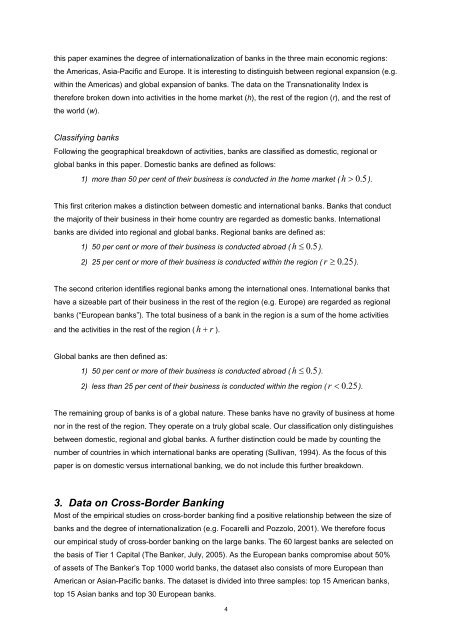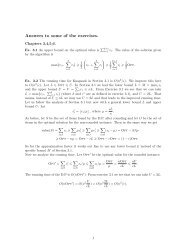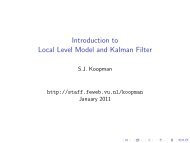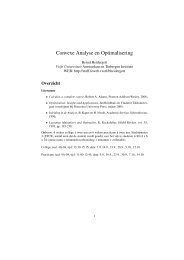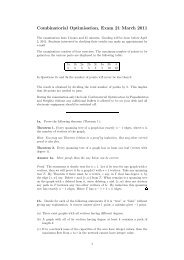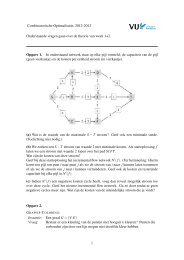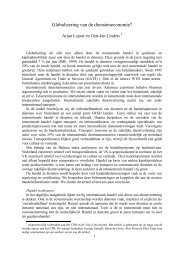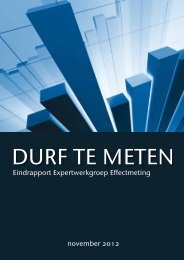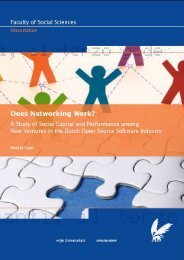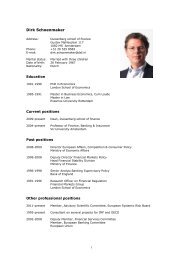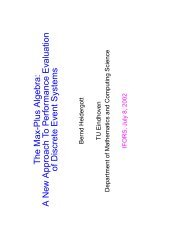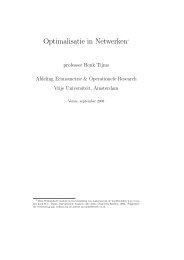Current State of Cross-Border Banking - Vrije Universiteit Amsterdam
Current State of Cross-Border Banking - Vrije Universiteit Amsterdam
Current State of Cross-Border Banking - Vrije Universiteit Amsterdam
Create successful ePaper yourself
Turn your PDF publications into a flip-book with our unique Google optimized e-Paper software.
this paper examines the degree <strong>of</strong> internationalization <strong>of</strong> banks in the three main economic regions:<br />
the Americas, Asia-Pacific and Europe. It is interesting to distinguish between regional expansion (e.g.<br />
within the Americas) and global expansion <strong>of</strong> banks. The data on the Transnationality Index is<br />
therefore broken down into activities in the home market (h), the rest <strong>of</strong> the region (r), and the rest <strong>of</strong><br />
the world (w).<br />
Classifying banks<br />
Following the geographical breakdown <strong>of</strong> activities, banks are classified as domestic, regional or<br />
global banks in this paper. Domestic banks are defined as follows:<br />
1) more than 50 per cent <strong>of</strong> their business is conducted in the home market ( h > 0.<br />
5 ).<br />
This first criterion makes a distinction between domestic and international banks. Banks that conduct<br />
the majority <strong>of</strong> their business in their home country are regarded as domestic banks. International<br />
banks are divided into regional and global banks. Regional banks are defined as:<br />
1) 50 per cent or more <strong>of</strong> their business is conducted abroad ( h ≤ 0.<br />
5 ).<br />
r ≥ 0.<br />
25<br />
2) 25 per cent or more <strong>of</strong> their business is conducted within the region ( ).<br />
The second criterion identifies regional banks among the international ones. International banks that<br />
have a sizeable part <strong>of</strong> their business in the rest <strong>of</strong> the region (e.g. Europe) are regarded as regional<br />
banks (“European banks”). The total business <strong>of</strong> a bank in the region is a sum <strong>of</strong> the home activities<br />
and the activities in the rest <strong>of</strong> the region ( h + r ).<br />
Global banks are then defined as:<br />
1) 50 per cent or more <strong>of</strong> their business is conducted abroad ( h ≤ 0.<br />
5 ).<br />
r < 0.<br />
25<br />
2) less than 25 per cent <strong>of</strong> their business is conducted within the region ( ).<br />
The remaining group <strong>of</strong> banks is <strong>of</strong> a global nature. These banks have no gravity <strong>of</strong> business at home<br />
nor in the rest <strong>of</strong> the region. They operate on a truly global scale. Our classification only distinguishes<br />
between domestic, regional and global banks. A further distinction could be made by counting the<br />
number <strong>of</strong> countries in which international banks are operating (Sullivan, 1994). As the focus <strong>of</strong> this<br />
paper is on domestic versus international banking, we do not include this further breakdown.<br />
3. Data on <strong>Cross</strong>-<strong>Border</strong> <strong>Banking</strong><br />
Most <strong>of</strong> the empirical studies on cross-border banking find a positive relationship between the size <strong>of</strong><br />
banks and the degree <strong>of</strong> internationalization (e.g. Focarelli and Pozzolo, 2001). We therefore focus<br />
our empirical study <strong>of</strong> cross-border banking on the large banks. The 60 largest banks are selected on<br />
the basis <strong>of</strong> Tier 1 Capital (The Banker, July, 2005). As the European banks compromise about 50%<br />
<strong>of</strong> assets <strong>of</strong> The Banker’s Top 1000 world banks, the dataset also consists <strong>of</strong> more European than<br />
American or Asian-Pacific banks. The dataset is divided into three samples: top 15 American banks,<br />
top 15 Asian banks and top 30 European banks.<br />
4


